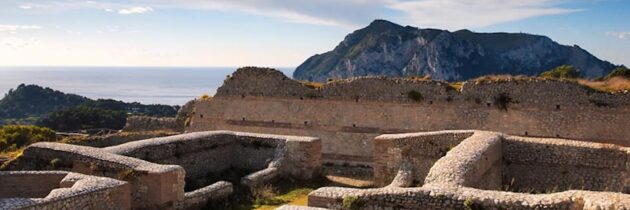Villa Jovis on Capri: traces of Tiberius amidst untamed nature and terraces overlooking the sea
Sometime a certain individual’s character leaves an indelible mark not only through his life and works, but also in a more concrete and tangible manner. Take, for example, Emperor Tiberius. Ancient biographers describe the second emperor of the Julius-Claudius dynasty as an introvert, not inclined to lively social interactions, and even cruel: a rather sad and suspicious person. This is a decidedly negative perspective that does not consider his bravery in battle during his youth, carried out in the shadow of Caesar and Octavius, in which he proved to have a rare military talent.
Augustus governed the empire from 14 to 37 A.D. and lived a rather reserved life, whose rule was resolute and peaceful. He decided, by nature of his upbringing and character, to stay away from courtly intrigues and gossip, and lived the last ten years of his reign on the island of Capri, governing the empire far from Rome, with all the risks this involved.
We mentioned above that there are places where the heart and soul of a strong personality take root. For Tiberius, this reflection of his spirit seems to have been Villa Jovis, the imperial palace on Capri where he spent the last years of his life.
The palace is located on the eastern end of the island, atop the promontory named for him, at 350 meters above sea level. There are no mechanized means by which to reach it. You must arm yourself with patience and stamina and walk up to it, a climb that requires a little less than an hour from Capri’s central square. However, take heart. The trail offers breathtaking views of the island and allows you to enjoy its untamed and prodigious natural beauty. The trail’s delights are not limited to the eyes, but also include the nose. In spring and summer, you may feel like you are walking through a natural perfumery, a mix of aromatic herbs, fruit flowers (particularly, the lemons of Capri, known local as femminiello) and jasmine. And in the spots where the panorama opens up and reveals the sublime, as Kant would say, you can rest and catch your breath on benches, filling your lungs and satisfying your eyes.
Once you reach the top, the site is so remote that you may feel as though you have reached a hermit’s refuge rather than an emperor’s palace. Just as you enter, on the right, there is a gated terraced, known as “Tiberius’ leap”. Legend has it that from here, after having tortured his victims and slashed their throats, the emperor tossed them into the sea. And as if that were not enough, if someone survived the fall, there was a group of sailors in the water who would beat him to death with clubs and sticks. This was recorded by Svetonio as well as others, and is part of the dark side of Tiberius’ legacy.
The palace has a surface area of 7,000 square meters, and includes an overlook to the north that encompasses the entire gulf of Naples, from Ischia to Punta Campanella, while the southern view takes in the entire island, providing glimpses into the center of Capri. Built at the edge of a steep precipice over the sea, the palace allows the visitor to enjoy all the hues and shades of blue in the water that surround the island.
The architecture includes elements of both a classic Roman villa as well as a small fort, with a compact, square design, from which certain areas are detached. As space was limited in the remote site, Villa Jovis extends over multi-level terraces. In the center are wells that collect rainwater, a crucial resource on an island that has no natural sources. In fact, the architects who designed the palace had to take into consideration the considerable problem of water supply. While water was abundant in the lower areas of the island, it was nonexistent at the top of the hills. Their bold plan was to build two or more enormous wells within the foundation of the villa itself. The rainwater collected in the wells provided pure drinking water, and was used for several subsequent centuries. The water collected was also used as a reserve for the spas that were part of the palace, including a changing area, a calidarium and a tepidarium.
The western side of the villa contained the servants’ quarters and the northern end was where the emperor and his closest confidantes resided, such as the Egyptian astrologer Thrasyllus of Mendes. It also contained the famous gallery, noted in its time for its ample size, which provides an unparalled view of the island. On clear days, you can just see Cilento to one side, and the entire gulf of Naples and beyond on the other.
The eastern end contained the throne room, while the ancient lighthouse used to signal land and for astronomical observation was destroyed by an earthquake shortly after Tiberius’ death.
Villa Jovis was rediscovered in the 17th century under the dominion of Carl of Bourbon. During the Bourbon dynasty, there were devastating excavations that resulted in the loss of almost all of the marble flooring. There were further excavations in 1932 that included restoring the palace ruins to some of its former glory.
The villa is open from 11:00am to 3:00pm (so get an early start) and is closed on Tuesdays in the first half of the month, and on Sundays in the second half. Ticket price: €2




 English
English Italian
Italian 






